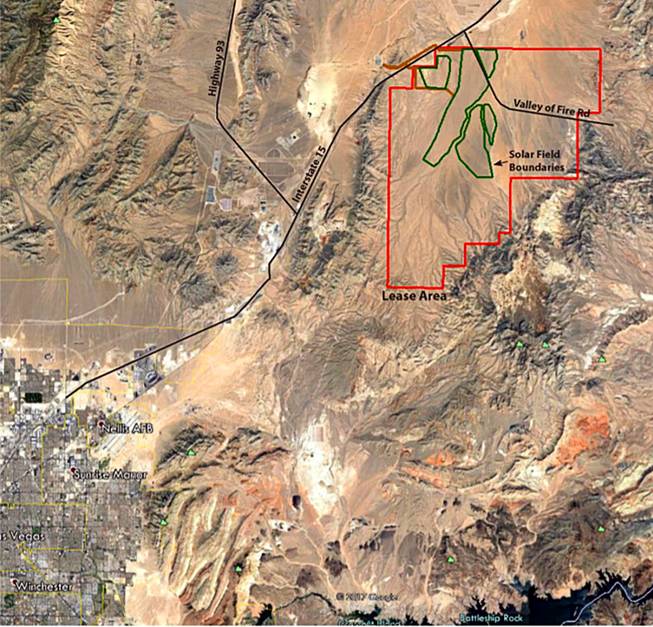
This image shows the proposed area of the Gemini Solar Project, 30 miles northeast of Las Vegas.
Published Friday, July 26, 2019 | 2 a.m.
Updated Thursday, Aug. 1, 2019 | 9:58 a.m.
A proposed solar project officials say would be the largest solar array in the country is causing some division among green energy proponents.
If approved, the Gemini Solar Project would generate 690 megawatts of electricity across 7,100 acres in the Mojave Desert just south of the Moapa River Indian Reservation. It’s about 30 miles northeast of Las Vegas and would send power to cities in Arizona, California and Nevada.
Another significant aspect of the project, which would be developed and maintained by Arevia Power LLC, is the plan to incorporate a battery storage component that would enable the plant to generate energy even when the sun isn’t shining. The project is slated to have one of the world’s largest battery systems and would have the ability to power more than 400,000 homes in Nevada. The project aligns with President Donald Trump’s America First Energy Plan, an approach that pushes for both renewable energy sources as well as coal and oil plants to be developed on public land, officials at the Bureau of Land Management said.
Third-generation Las Vegan Max Carter voiced his support for the project, saying the construction would create well-paying jobs in addition to making solar energy more accessible to those who can’t afford rooftop solar arrays. He spoke this week during one of two presentations from the BLM on the project.
“The move to sustainable energy is one that needs to happen,” he said.
While environmentalists are generally supportive of any renewable energy effort, what gives many green energy proponents pause is the project’s environmental impact on surrounding wildlife, particularly the desert tortoise habitat, said Patrick Donnelly, Nevada director of the Center for Biological Diversity.
The proposal would result in the loss of 7,071 acres of habitat that would impact 220 desert tortoises. The plan would also destroy 718 acres of three-corner milkvetch, an endangered plant that grows around the project site, as well as cause long-term, damaging effects to the Old Spanish National Historic Trail, according to the BLM.
The BLM provided alternatives to the plan, one of which is a mowing method, which officials said would minimize direct vegetation removal. Under this method, a less invasive way to trim the shrubbery, only 176 acres of desert tortoise habitat would be affected, and the population could be reintroduced to the site after construction. A similar mowing method was used at an 80-acre solar facility in Pahrump.
But some desert tortoise advocates still say the mitigating factors of this method aren’t enough.
Officials from Basin and Range Watch, a nonprofit with intentions to “defend the desert,” have long been opposed to the project.
“The mowing alternative presents a lot of problems,” said Kevin Emmerich, the Basin and Range Watch co-founder. “The (BLM) made it look like a win-win, basing it on the one in Pahrump. On that site, most of the vegetation is not quite as nutritious and is degrading to the habitat quality.”
Emmerich also said reintroducing tortoises to the habitat causes problems, as many of them become disoriented, therefore more vulnerable to predators.
“I’m surprised BLM hasn’t given us reduced impact alternative,” he said.
It’s still difficult to determine how effective the mowing technique would be in preserving desert tortoise habitat, Donnelly said. He said the mowing method is still the best mitigating alternative proposed by the BLM.
“I think it’s hard to say what the effects of (mowing) would be,” Donnelly said. “Doing it at this scale would be an experiment … This (project) is literally 100 times larger than the Pahrump project. It’s never been tried at this scale.”
Retired electrician Forrest Darby said he has worked on a variety of power plants throughout his career, many of which were powered by coal and gas. He’s shocked to see anyone against this project.
“For as long as I can remember, many of my friends have been unhappy with oil and … how much carbon we put in the air,” he said. “Everybody for many, many years has said bring on the solar. It’s finally here and I really am surprised that there is anyone here who is against it.”
Donnelly said the Center for Biological Diversity has not yet taken an official stance on the proposal, but noted that something needs to be done in addressing the effects of climate change. His organization strongly advocates for rooftop solar arrays.
“We firmly believe that we could generate most or all of our electricity from rooftops in Las Vegas,” he said. “Most of our electricity comes from natural gas that is fracked, causing severe impacts to our water and wildlife.”
The public comment period ends on Sept. 5. If the plan is approved, construction would begin in March 2020.
CORRECTION: This story has been updated to correct the spelling of Forrest Darby's name. | (August 1, 2019)
